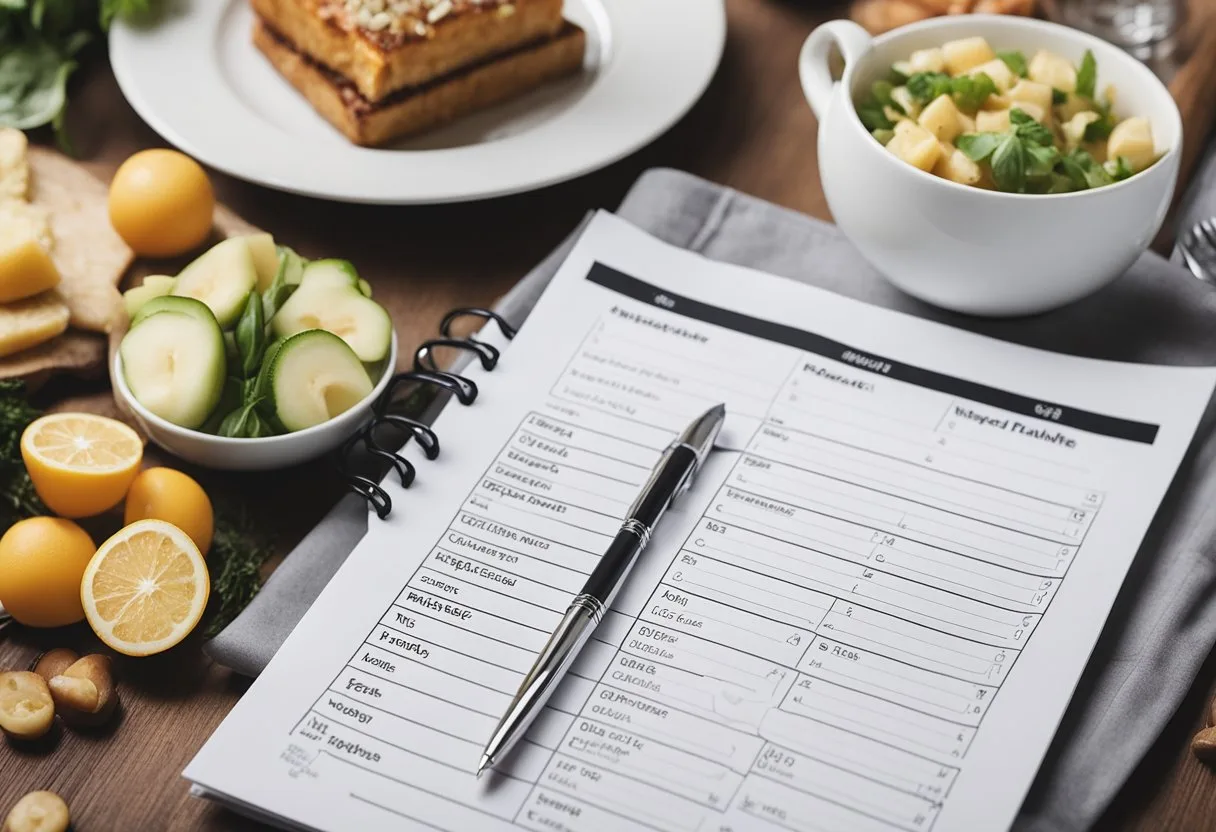Meal planning can be a daunting task, especially for individuals with busy schedules. However, meal planner printables can help simplify the process and make it more manageable. These printables come in various formats, allowing users to choose the one that best suits their needs.
Weekly and monthly templates are the most common types of meal planner printables available. These templates provide users with a clear overview of their meals for the week or month, making it easier to plan ahead and ensure that they have all the necessary ingredients on hand. Some meal planner printables also include sections for grocery lists, making it easier to keep track of what needs to be purchased.
In addition to weekly and monthly templates, there are also meal planner printables designed for specific diets, such as keto and weight watchers. These printables can be especially helpful for individuals who are following a particular diet plan and need to keep track of their meals and macros. Overall, meal planner printables are a great tool for anyone looking to simplify their meal planning process and stay organized.
Understanding Meal Planning
Meal planning is the process of deciding what to eat and preparing a list f ingredients to make those meals. It is an essential part of a healthy lifestyle, and it can help people save time and money. In this section, we will discuss the benefits of meal planning and how it is different from meal prepping.
Benefits of Meal Planning
Meal planning has several benefits. Firstly, it ensures that people eat healthy meals. By planning meals in advance, people can ensure that they have a balanced diet that includes all the necessary nutrients. Secondly, meal planning saves time.
Through planning meals for the week, people can avoid the stress of deciding what to cook each day. It saves money as people can buy ingredients in bulk and avoid buying unnecessary items. Finally, meal planning reduces food waste as people only buy what they need.
Meal Planning vs. Meal Prepping
Meal planning and meal prepping are often confused, but they are different. Meal planning involves deciding what to eat and preparing a list of ingredients to make those meals. In contrast, meal prepping involves preparing meals in advance and storing them for later use. Meal prepping is a great way to save time during the week, but it requires more time and effort upfront. Meal planning is a more flexible approach as people can change their meal plans if necessary.
Here are some meal planning tips to help people get started:
- Set aside time each week to plan meals and create a shopping list.
- Consider the number of people who will be eating the meals and their dietary restrictions.
- Plan meals that can be made in bulk and frozen for later use.
- Use meal planning printables to help organize meal plans and shopping lists.
- Keep healthy snacks on hand to avoid the temptation of unhealthy snacks.
Choosing Your Meal Planner Format

When it comes to meal planning, choosing the right format can make all the difference. There are two main formats to consider when selecting a meal planner: printable and digital.
Printable vs. Digital
Printable meal planners come in a variety of formats, including PDFs and images. They can be printed out and filled in by hand or typed into on a computer before printing. Printable meal planners can be a great option for those who prefer a physical copy or who like to customize their planner with stickers or other decorations.
On the other hand, digital meal planners can be accessed on a computer or mobile device. They offer the convenience of being able to make changes on-the-go and can be easily shared with others. Digital meal planners also often come with additional features such as grocery list integration and recipe suggestions.
Weekly vs. Monthly Planners
Another important consideration when selecting a meal planner is whether to opt for a weekly or monthly format.Weekly meal planners allow you to plan out your meals on a day-by-day basis. T Monthly meal planners, on the other hand, allow you to plan out your meals for the entire month at once. This can be helpful for those who like to have a broader view of their meal plan and who prefer to shop for groceries less frequently.
When deciding between weekly and monthly meal planners, it’s important to consider your own preferences and lifestyle.
Selecting the right meal planner format is an important decision that can impact your meal planning success. Whether you opt for a printable or digital format and whether you choose a weekly or monthly planner ultimately comes down to personal preference and lifestyle.
Setting Up Your Meal Planner
A meal planner is a great tool to help you stay on track with your dietary goals. Here are some tips on how to set up your meal planner:
Determining Your Dietary Goals
Before setting up your meal planner, it is important to determine your dietary goals. This can include goals such as losing weight, gaining muscle, or simply maintaining a healthy diet. Once you have determined your goals, you can plan your meals accordingly.
Incorporating Variety and Nutrition
When planning your meals, it is important to incorporate variety and nutrition. This can be done by including a variety of fruits and vegetables, lean proteins, and whole grains. It is also important to pay attention to portion sizes and to limit the amount of unhealthy foods.
To make your meal planner more effective, you can include a notes section where you can write down any additional information about your meals. You can also include a water tracker to help you stay hydrated throughout the day.
When it comes to the design of your meal planner, you can choose a color and border that you find visually appealing. However, it is important to remember that the most important aspect of your meal planner is the content.
Finally, if you are tracking your calories, you can include a section where you can write down the number of calories in each meal. This can help you stay within your daily calorie limit.
Building Your Grocery List

When it comes to meal planning, building a grocery list is a crucial step in ensuring that you have all the ingredients you need for your meals. A well-organized grocery list can help you save time and money by avoiding unnecessary purchases and ensuring that you have everything you need for each meal.
Organizing Shopping List Categories
One effective way to organize your grocery list is by category. Grouping items according to categories like produce, dairy, and meat can help you navigate the store more efficiently and ensure that you don’t forget anything. Printable grocery lists are a great way to help you stay organized and ensure that you don’t forget anything.
Quantities and Budgeting
Another important consideration when building your grocery list is quantities and budgeting. It’s important to consider how much of each item you need for your meals and how much you can afford to spend. One way to help with budgeting is to use a printable grocery list that includes space for you to enter quantities and prices.
By taking the time to organize your grocery list and consider quantities and budgeting, you can ensure that you have everything you need for your meals and avoid overspending at the store. Printable grocery lists can be a helpful tool in this process, allowing you to stay organized and focused while shopping.
Meal Plan Templates and Tools
Meal planning can be a great way to save time and money, and meal plan templates can make it easier to get started. There are a variety of templates and tools available online that can help you plan out your meals for the week or month. Here are some options to consider:
Weekly Meal Plan Templates
Weekly meal plan templates are a popular option for those who like to plan their meals in advance. These templates typically include space for breakfast, lunch, and dinner for each day of the week, as well as a section for snacks or desserts. Some templates also include space for a grocery list, making it easy to plan your meals and shop for ingredients at the same time.
One example of a weekly meal plan template is the free customizable templates available on Canva. These templates feature a variety of designs and layouts, making it easy to find one that fits your style and needs.
Daily Meal Plan Options
For those who prefer to plan their meals on a daily basis, there are also daily meal plan options available. These templates typically include space for breakfast, lunch, and dinner for a single day, as well as a section for snacks or desserts.
One example of a daily meal plan template is the free printable templates available on World of Printables. These templates include space for each meal of the day, as well as a section for notes or reminders.
Meal plan templates and tools can be a great way to simplify your meal planning process and stay organized. Whether you prefer to plan your meals on a weekly or daily basis, there are a variety of options available to help you get started.
Recipes and Menu Ideas
Breakfast, Lunch, and Dinner
Having a meal planner printable can make meal planning a lot easier. With over 150 easy dinner ideas, meal planning can be a breeze. The meal plan printables can help you organize your menu for the week, so you’ll know exactly what to cook.
For breakfast, there are a variety of options that can be included in your meal planner printable. Some great ideas include oatmeal, smoothies, eggs, and pancakes. For lunch, salads, wraps, and sandwiches are great options. Dinner can be a bit more complex, but with a meal planner printable, it can be simple. Some dinner ideas include chicken, fish, pasta, and rice dishes.
To help with meal planning, recipe cards can be included in the meal planner printable. Recipe cards can be used to keep track of your favorite recipes, and can be easily accessed when you need them.
Snacks and Healthy Alternatives
Snacks are an important part of any meal plan. They can help keep you full between meals and can provide a boost of energy when needed. Some healthy snack options include fruits, vegetables, nuts, and seeds.
Healthy alternatives can also be included in the meal planner printable. These can include swaps for less healthy ingredients, such as using Greek yogurt instead of sour cream or using whole wheat flour instead of white flour.
Ameal planner printable can be a great tool for anyone looking to simplify their meal planning process. With recipe cards, easy dinner ideas, and healthy alternatives, meal planning can be a breeze.
Managing Leftovers and Food Inventory

Storing and Reusing Leftovers
One of the best ways to save money and reduce food waste is to store and reuse leftovers. Meal planner printables can help you keep track of what leftovers you have and when they need to be eaten. To store leftovers properly, make sure to put them in airtight containers and label them with the date they were made. This will help you remember when they need to be eaten by and prevent them from going bad.
When it comes to reusing leftovers, there are many creative ways to incorporate them into new meals. For example, leftover rice can be turned into fried rice, and leftover chicken can be used in a salad or sandwich. By using leftovers in new ways, you can save time and money while also reducing food waste.
Pantry, Fridge, and Freezer Inventory
Keeping track of what you have in your pantry, fridge, and freezer can be a daunting task. However, meal planner printables can make this process much easier. By using a pantry, fridge, and freezer inventory sheet, you can keep track of what food you have on hand and when it expires.
When it comes to organizing your pantry, make sure to group similar items together and keep them in labeled containers. This will help you quickly find what you need and prevent food from going bad. It’s important to check expiration dates regularly and throw out any expired items.
By using meal planner printables to manage your leftovers and food inventory, you can save time and money while also reducing food waste. Whether you’re trying to stick to a budget or simply want to be more organized in the kitchen, meal planner printables can be a valuable tool.
Additional Resources and Inspiration
When it comes to meal planning, there are plenty of resources available to help make the process easier and more efficient. In addition to the free printable meal planner templates discussed earlier, there are a variety of other resources and sources of inspiration that can be helpful.
Free Printable Resources
There are many websites that offer free printable resources for meal planning and prep. For example, Printabulls offers a range of meal planning planner pages that can be printed and used to help organize your weekly menu. These pages come in a variety of sizes and formats, so you can choose the one that works best for you.
Another great resource for free meal planning printables is Frugal Minimalist Kitchen. This website offers a range of printable resources, including a minimalist meal plan printable, a meal planner with grocery list, and a healthy meal plan checklist. These printables can be a great way to stay organized and focused when planning your meals.
Finding Inspiration on Pinterest
Pinterest can be a great source of inspiration when it comes to meal planning and prep. There are countless boards and pins dedicated to meal planning, with ideas for everything from healthy snacks to family dinners. One way to use Pinterest for meal planning is to create a board specifically for recipes and meal ideas. This can be a great way to keep track of your favorite recipes and meal ideas, as well as to discover new ones.
In addition to recipe ideas, Pinterest can also be a great source of inspiration for meal prep and organization. There are many pins and boards dedicated to meal prep tips and ideas, as well as to organization and storage solutions. By exploring these resources, you can find new ways to streamline your meal planning and prep process, making it easier and more efficient than ever before.
There are many resources and sources of inspiration available to help make meal planning and prep easier and more efficient. By exploring these resources and finding the ones that work best for you, you can create a meal planning system that is both effective and enjoyable.
Frequently Asked Questions

How can meal planner printables be effectively used to organize weekly meals?
Meal planner printables can be effectively used to organize weekly meals by providing a structured way to plan meals in advance. To use a meal planner printable, individuals can start by selecting a template that suits their needs and preferences. They can then fill in the template with meals they plan to cook for the week, taking into account dietary restrictions and preferences.
What are the benefits of incorporating a grocery list into a meal planner template?
Incorporating a grocery list into a meal planner template can be beneficial in several ways. Firstly, it helps individuals to stay organized and avoid forgetting essential ingredients while grocery shopping. Secondly, it can help individuals save money by preventing impulse purchases and reducing food waste. Finally, it can also help individuals eat healthier by ensuring they have all the necessary ingredients to prepare nutritious meals.
Are there any free meal planner templates available that include sections for tracking nutritional information?
Yes, there are several free meal planner templates available online that include sections for tracking nutritional information. These templates can help individuals to monitor their calorie intake, macronutrient ratios, and other nutritional information to ensure they are meeting their dietary goals.
Can individuals find a meal planner printable that is designed for a family with different dietary needs?
Yes, there are meal planner printables available that are designed for families with different dietary needs. These templates typically include sections for each family member’s meal plan, allowing for customization based on individual dietary restrictions and preferences.
What is the best way to personalize a meal planner template to fit a meal prep routine?
The best way to personalize a meal planner template to fit a meal prep routine is to select a template that aligns with the individual’s meal prep habits. For example, if an individual prefers to meal prep on Sundays, they can select a template that starts on Monday and includes a section for meal prep. You can modify the template to include specific meals they enjoy and adjust serving sizes to fit their needs.
How do meal planner printables compare to meal planner apps in terms of ease of use and convenience?
Meal planner printables and meal planner apps both have their advantages and disadvantages. Meal planner printables are typically more customizable and can be tailored to an individual’s specific needs. They also do not require an internet connection and can be accessed offline.
On the other hand, meal planner apps often have more features and can provide more detailed nutritional information. They are also more convenient for individuals who prefer to use their smartphones or tablets to plan their meals.




